Build-A-Rig Round 2, SilverStone vs. Crucial: The $800 PC Showdown
by Daniel Williams on November 12, 2015 8:00 AM EST- Posted in
- Build-A-Rig
- Systems
- Crucial
- SilverStone
System Performance
First on our list is to see how well these builds will do as "daily drivers" when used for general tasks (e.g. not gaming). While office workloads have traditionally been CPU-bound they have also traditionally been light on parallelism, meaning the benefits of multi-core CPUs haven’t always been consistent. What we have coming will be an interesting look in the tradeoff between more threads via Hyper-Threading and more clock speed.
Meanwhile I’ve also gone ahead and thrown in the overclocked numbers on the Mighty Milo since it was an overclocking-capable setup. The primary focus for this article is on stock performance, but it gives us a second look at what Mighty Milo can do with its overclocking abilities taken into account.
Starting with PCMark 8 then, PCMark provides various usage scenarios (home, creative and work) and offers ways to benchmark both baseline (CPU-only) as well as OpenCL accelerated (CPU + GPU) performance. We benchmarked select PCs for the OpenCL accelerated performance in all three usage scenarios. These scores are heavily influenced by the CPU in the system.
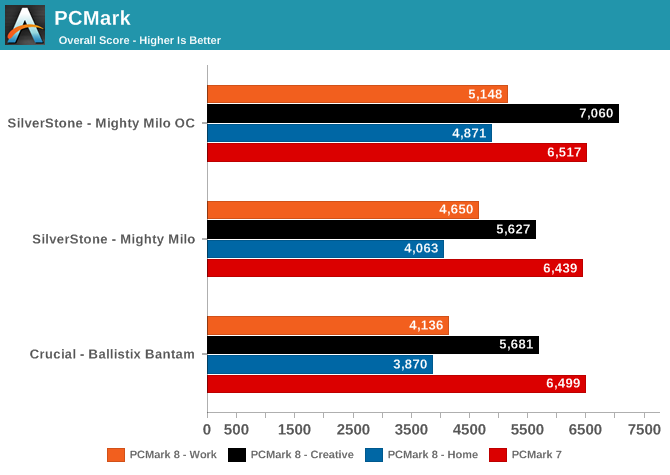
On PCMark 7 the two systems are neck-and-neck. However on PCMark 8 the systems start pulling apart, with Mighty Milo taking the lead. The Work subtest in particular gives Mighty Milo a clear advantage, most likely due to the advantages of OpenCL acceleration on a faster video card.
Moving on, we have CINEBENCH R15, an image rendering benchmark. CINEBENCH provides three benchmark modes - OpenGL, single threaded and multi-threaded. Evaluation of select PCs in all three modes provided us the following results.
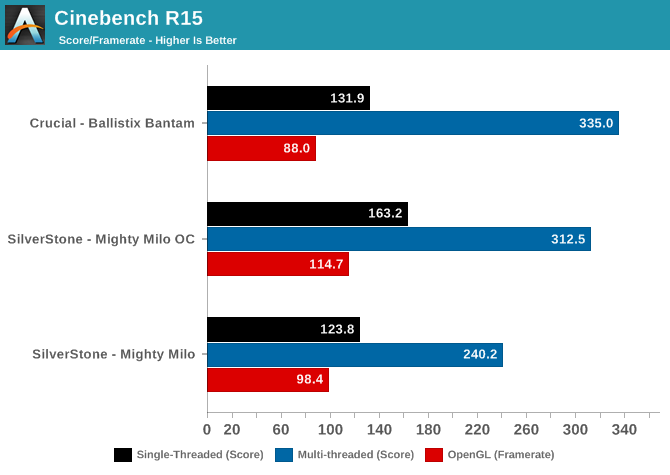
Single threaded performance on Cinebench is essentially a product of IPC and clock speed. With both systems here housing Haswell chips the competition drops down to a simple clock speed war with the Mighty Milo dragging behind at stock speeds and pulling a nice lead after pushing the clocks up. Though when we move to the multithreaded test the Hyper-Threading featured by the Ballistix Bantam’s Core i3-4170 trumps the overclocked Milo and sends them home with a silver medal.
On the GPU front SilverStone’s build simply has a faster GPU, and apparently is leaving a large chunk of performance on the table at stock. This is a trend that we will see form with this computer as the Mighty Milo continues to open up with more clock speed.
For a look at video encoding performance we have results courtesy of x264 HD Benchmark v5.0. This is simply a test of CPU performance with good scaling with both core count and individual core performance.
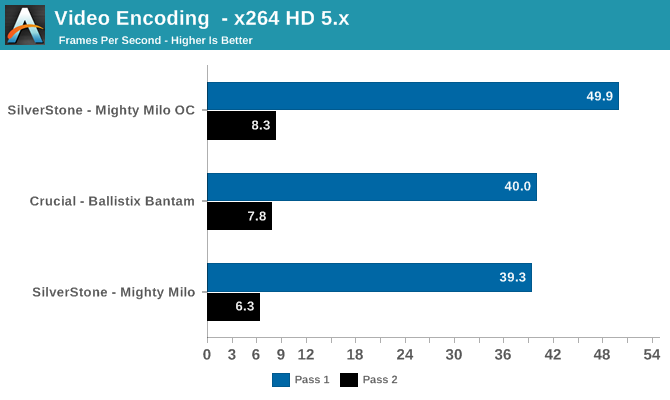
We see much the same trend developing here with x264. At stock the Crucial system holds the lead thanks to its faster Core i3 processor, though by the time we reach pass 2 things are surprisingly close. Otherwise when overclocked the Mighty Milo’s much higher clockspeed lets it really open up.
Up next, 7-Zip is a very effective and efficient compression program, often beating out OpenCL accelerated commercial programs in benchmarks even while using just the CPU power. 7-Zip has a benchmarking program that provides tons of details regarding the underlying CPU's efficiency. In this subsection, we are interested in the compression and decompression MIPS ratings when utilizing all the available threads.
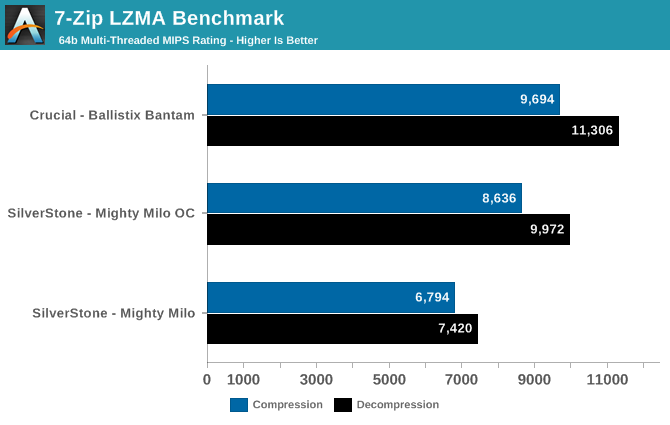
Decompression is one area I definitely felt was lacking while setting up the Mighty Milo for testing. Any file that I decompressed appeared to do so much slower than I was used to. Sure enough the numbers came and confirmed my observations. Here overclocking helps but ultimately the Core i3 in Crucial’s build provides a slightly better experience, reiterating that overclocking alone can’t always make up for a difference in performance-enhancing features.
Meanwhile, as businesses (and even home consumers) become more security conscious, the importance of encryption can't be overstated. TrueCrypt is a popular open-source disk encryption program can take advantage of the AES-NI capabilities of modern processors, and even though TrueCrypt is no longer under development, its internal benchmark provides some interesting cryptography-related numbers to ponder.
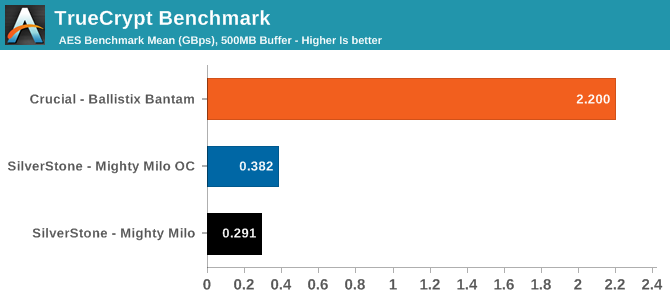
We saw these results before in Ian's review of the G3258. One big drawback of Intel's entry-level CPUs is the lack of hardware AES cryptography support. Due to this we see the Core i3-4170 offering nearly ten times the throughput of the Pentium, even a respectable overclock hardly put a chip in the gap (no pun intended). Many don't feel the need for cryptography support. But anyone that uses it on a regular basis will definitely appreciate, and possibly even need, the added performance.
Agisoft PhotoScan is a commercial program that converts 2D images into 3D point maps, meshes and textures. The program designers sent us a command line version in order to evaluate the efficiency of various systems that go under our review scanner. The command line version has two benchmark modes, one using the CPU and the other using both the CPU and GPU (via OpenCL). The benchmark takes around 50 photographs and does four stages of computation:
Stage 1: Align Photographs
Stage 2: Build Point Cloud (capable of OpenCL acceleration)
Stage 3: Build Mesh
Stage 4: Build Textures
We record the time taken for each stage. Since various elements of the software are single threaded, others multithreaded, and some use GPUs, it is interesting to record the effects of CPU generations, speeds, number of cores, DRAM parameters and the GPU using this software.
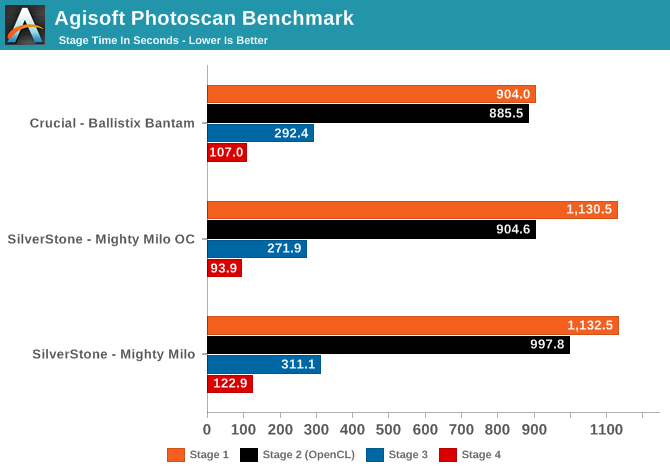
Thanks to its more powerful Core i3 CPU, Crucial’s Ballistix Bantam pulls a win here. The lack of AVX and HT really hits the Mighty Milo, especially in the time-intensive first stage. Even overclocked, the Milo can improve on the shorter, latter stages, but it can’t close the gap on stage 1.
Our next system performance benchmark is the Dolphin Emulator. This is again a test of the CPU capabilities, and how well a CPU can handle emulating the Nintendo Wii’s PowerPC 750 CPU.
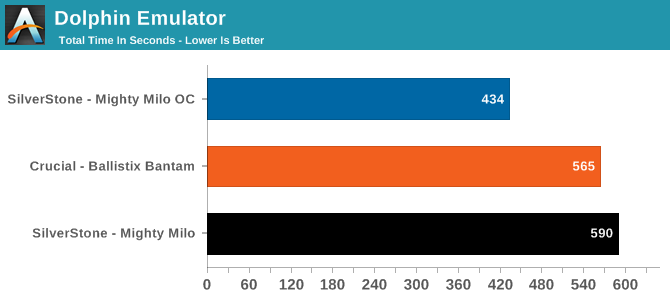
Dolphin is a pretty straightforward lightly-threaded CPU throughput test. At stock the faster Crucial system holds the advantage, otherwise the heavily overclocked SilverStone system can really run down the score.
Last but not least, we have a slightly more specialized test with Iperf. The network bandwidth testing tool gives us a look at the performance of the included 2x2:2 802.11ac Wi-Fi solutions in each build.
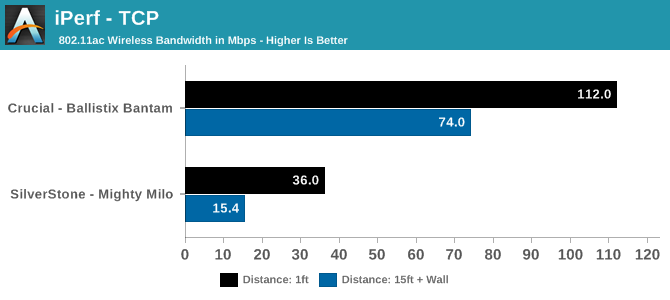
I'm not sure if I should be surprised here from the results. I was expecting to see some crazy numbers having a couple of wireless ac motherboards to work with here. Turns out that not all 802.11ac setups are created equal. My first assumption is that the antennas on the Mighty Milo are just not in as ideal a location being planted on the back of the machine, while for lack of better creativity even having the Ballistix Bantam's antenna stuck to the side of the case yielded numbers that while not amazing are still appreciably better than any real world 802.11n bandwidth I've seen.
I was a mix of surprised, confused, and then disappointed over the Wi-Fi performance of the Mighty Milo. After some quick research to see what I was doing wrong though I found that my measurements were in line with those found by previous journalists who had hands-on time with this motherboard.
Now that we have had a look at general system performance let's go and see how they do when we want to have a little fun.










43 Comments
View All Comments
DanNeely - Thursday, November 12, 2015 - link
At the same time, the efficiency penalty from being significantly below the PSUs sweet spot is much larger than from being near its max output. You're also paying a lot in higher running costs now for that big low efficiency PSU. At typical US energy prices, if you leave it on 24/7 it's about $30/year; and is still $10/year if only on for 8 hours a day (triple these numbers for somewhere like Hawaii or Germany that have really high power costs). A 450/500W model makes a lot more sense now and would do much better in the face of your potential high end upgrade than the current one does now. If you're going with an oversized PSU now because you don't want to buy a bigger one after a future planned upgrade, it really pays to get a high efficiency model to avoid the much higher operational costs when the system is at idle.BrokenCrayons - Thursday, November 12, 2015 - link
The cost concern would vary from place to place, as you've pointed out, but I think the difference in cost even in areas where electrical rates are high aren't that significant. Say you'd spend $90 a year feeding a computer electricity to leave it on 24/7 in a high cost area of the world. A more efficient power supply that burns less power might help, but you'd realize a pretty small overall price difference over the useful lifespan of the computer. I don't deny the idea of a more efficient, lower wattage PSU being a better choice, but I don't think electrical costs are a very significant factor in computing hardware unless the savings are pretty dramatic (say netbook vs gaming desktop) or involve large numbers of computers in a business/enterprise environment.However, I wouldn't even upgrade a system like the Crucial box unless I could do so by waiting a few GPU generations to get more performance for less wattage rather than grabbing a higher end and more demanding current generation part, but I'm also pretty happy with gaming on a GeForce GT 730. If my desktop vanished today, I'm also not against using my admittedly old Atom n270 netbook as my only computer since gaming isn't a major concern. As such, I'm guessing you're more well informed and better suited to make a recommendation. :)
DanNeely - Friday, November 13, 2015 - link
You appear to be misunderstanding my numbers. It's not $90 total, it's $90 *more*. The rule of thumb conversion factor for something on 24/7 is that at a price of 10 cents/KWH is equal to 1 dollar/watt-year. Somewhere that power is 10c/kwh (slightly below the US average) the Might Milo would cost $38/year left at idle, Ballistic Bantam would cost $64; a $26/year difference. At 35c/kwh its $133 vs $224 per year for power, that 26 watt difference ends up costing an extra $91/year.BrokenCrayons - Tuesday, November 17, 2015 - link
Oh, okay! Sorry for the misunderstanding. I do think the cost difference isn't that significant in the grand scheme of things. In the hypothetical college student in a dorm situation, electrical inefficiency isn't going to result in a cost increase unless the university is metering individual dorms. They didn't when I was a student, but that isn't even remotely recent history. For someone who's paying their own electrical bills, $90 a year is only the price of one person's dinner at a nice restaurant. I still agree the power supply is overkill, but energy costs just aren't dramatic enough to matter. Don't buy that extra pair of shoes or skip out on girls/boys night out once or twice -- you won't miss them anyway since you'll be busy playing whatever game it is that makes you happy anyway.nikaldro - Thursday, November 12, 2015 - link
I think you should have tested frame times. 2 vs 4 threads can make a substantial difference sometimes.tipoo - Thursday, November 12, 2015 - link
Yeah, Digital Foundry has pretty much solidified that even two extra virtual threads make a huge difference. 2 cores alone can sometimes drop a lot of frames in a game, two cores with hyperthreading for four virtual threads usually does really well. To the point where the CPU can push over 60fps in games if the GPU is up to it.geniekid - Thursday, November 12, 2015 - link
It's interesting to see how balanced both systems are - they both run into various bottlenecks depending on the application/settings. Objectively, I feel Crucial's more balanced system is the better choice for a true back-to-school system but, subjectively, overclocking SilverStone's G3258 by 34% is much cooler. I'd recommend the former to someone else. I'd take the latter for myself :)Flipper34 - Thursday, November 12, 2015 - link
Not too bad for the price.crimson117 - Thursday, November 12, 2015 - link
Giveaway, shmiveaway! I hope I win.reorx - Thursday, November 12, 2015 - link
This is the perfect PC build for school - especially that Silverstone slim case!